OBERTSHAUSEN, Germany — February 21, 2023 — Close cooperation between educational institutions and industry is vital in today’s world: they can inspire young students to new ideas, offer them future opportunities and awaken new passions. With this in mind, the KNIT COUTURE upcycling project was initiated between STOLL — part of the KARL MAYER GROUP — and the TEXOVERSUM Faculty of Textiles at Reutlingen University as part of the 3rd semester for fashion design. Both partners are leading the way in their industry. The results are clear to see.
Both the supervising professor Natalie Seng and project partners at STOLL have been impressed by the students’ creative achievements. “The works are evidence of extraordinary creativity and diversity. It is not a given that students in the 3rd semester are already able to demonstrate such creative achievement. We are excited to see how the students will develop throughout their studies and of course hope that we have been able to spark an interest in flat knitting as part of this project,” says Ellen Judith Müller, 3D designer at STOLL.
Cooperating with the best
STOLL is a producer of flat knitting machine technology and has a wide range of knitted swatches, as well as in-shape and seamless knitted garment products that make the possibilities afforded by flat knitting technology tactile. Regular trend collections constantly symbolise new technological possibilities.
Reutlingen University was recently named as Top University in Baden-Württemberg by the ratings portal Study-Check. It is second in the nationwide rankings for universities of applied sciences. As part of their fashion design studies, the students at TEXOVERSUM in Reutlingen focus on future issues facing the fashion industry, such as sustainability and digitization, where there are conflicts between handicrafts and consumer society.
A lens on sustainability
The joint KNIT COUTURE project also primarily focused on the topic of sustainability. A total of 13 students were asked to draw inspiration from historical knitting patterns donated by STOLL and to create new looks that brought old materials into a modern context, thereby giving them a new value. The young creatives developed mood boards, colour and collection concepts, and subsequently extended them into a compilation of at least ten different looks. The final piece included four outfits with two real-life models and two digital 3D simulations. These resultant diverse creations breathed new life into STOLL’s historic knitting patterns.
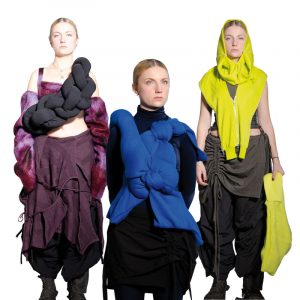
Turning Old Into New And Beyond
Lisa Bassot, for example, wants to appeal to a young target audience with her “Old is the new new” collection, featuring a modern design language. She is focusing on youngsters who want to get to grips with the production, personalisation and possible combinations of their clothes. Lisa Bassot wants to encourage people to wear clothes for several years and to value their wardrobe. These outfits – made from what already exists – stand out thanks to their creativity: knitted trousers were stuffed and knotted into novel tops. Tops were turned into a multi-layered skirt with lacing, and two jumpers were transformed into accessories.
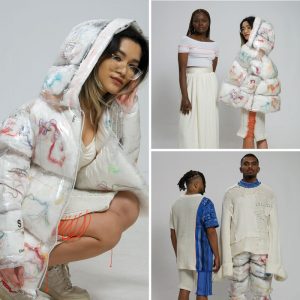
Group work by Janna Sautter and Özgenur Kesimal also demonstrates a feel for current trends: The two designers’ “Break the System” collection reflects how modern upcycling can look through street-style-inspired outfits. Their designs not only reflect knitted STOLL patterns but also include their packing materials. In this case, novel knitwear creations have been combined with filled plastic puffer garments. As such, both designers are making a statement that no material is beyond upcycling.
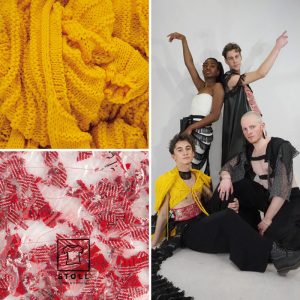
Packaging also inspired Kirsten Hippmann and Klara Mahn to create their “Selfesque” collection. The students stuffed real waste material with cut-up knitting pattern snippets and used them to make corsages and a cape. They also used excess yarn to develop new knitting patterns on the university’s own STOLL warp knitting machine. The new creations were combined with historical pattern pieces, satin, borders and feather accessories.
In contrast, Karina Gaus placed nature at the very heart of her collection: “Tails of the forest”. The budding designer explains that she believes nature is a magical place that needs to be protected. Stylistically, she was inspired by fairy-tale creatures. As part of her collection, she transformed a variety of STOLL knitting patterns into fantastic new creatures using smocking techniques, layering, crimping and embroidery.
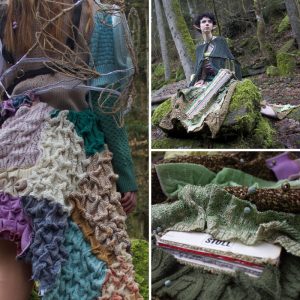
Bilgen Colak also focuses on nature with her work “Contamination”. With polluted and deconstructed models, she is creatively denouncing the current environmental and marine pollution. To do so, she distorted knitting patterns that were originally colourful using dyeing techniques and foil printing to visualise how nature is being contaminated.
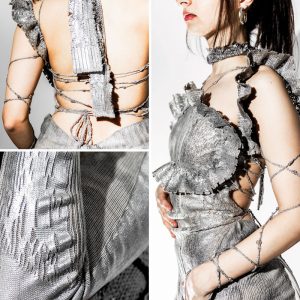
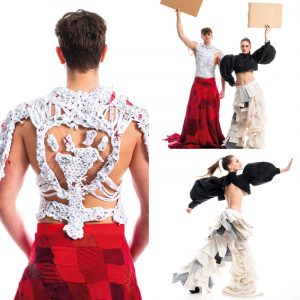
Sophia Heinisch refers to current social issues in her collection, including the latest women’s movement in Iran, and demands for upholding human rights. “Through my ‘CHANGE.org’ collection, I want to pay tribute and express my admiration to those who are courageous enough to stand up and fight for a better future,” says Sophia Heinisch. Her collection represents empowerment: the courage to express oneself freely and individually. With skilled craftsmanship, she has combined different techniques, such as patchwork, crochet, screen-printing and classic pattern construction, to create expressive models.
Posted February 21, 2023
Source: STOLL/Karl Mayer Group




